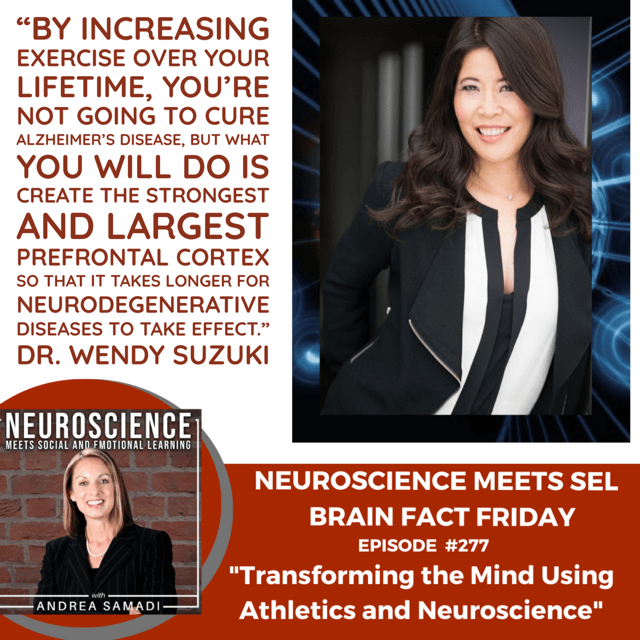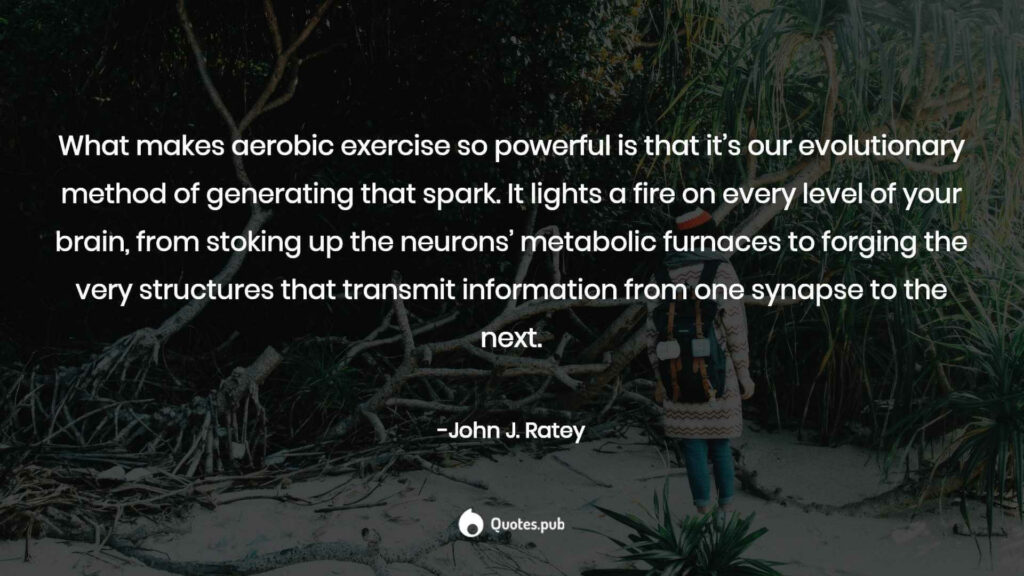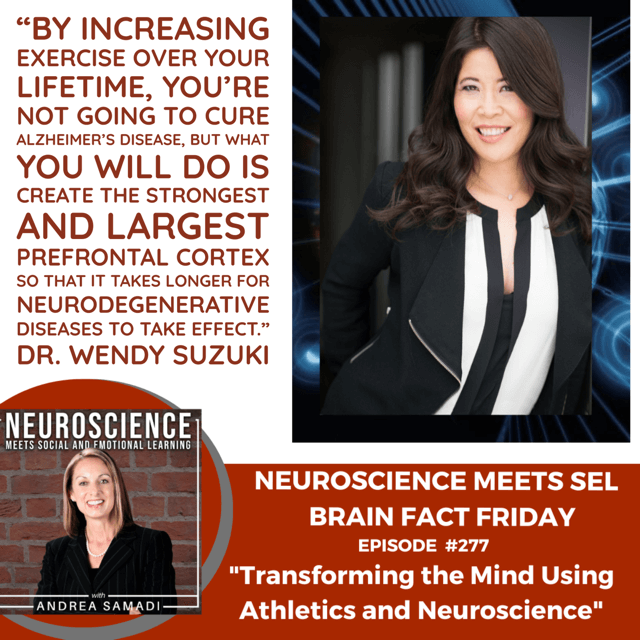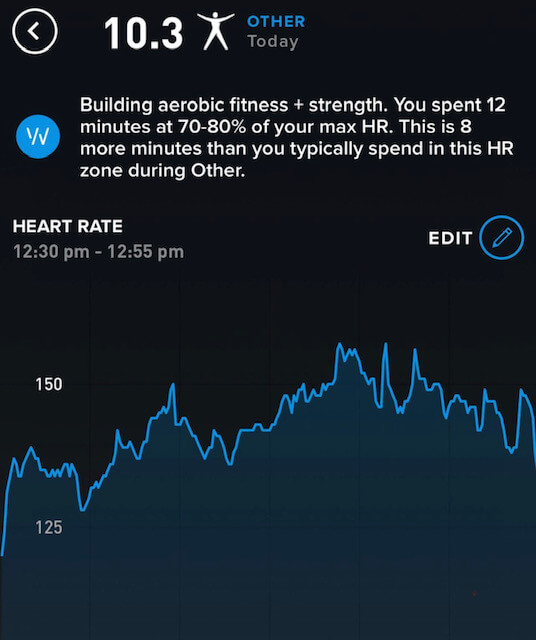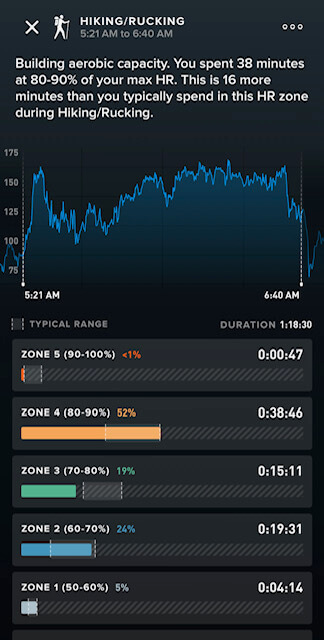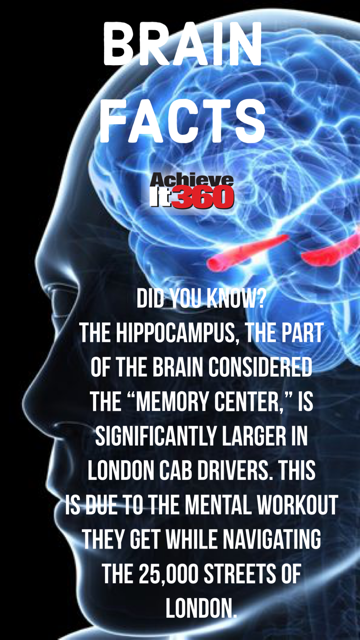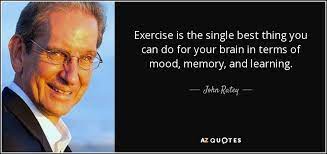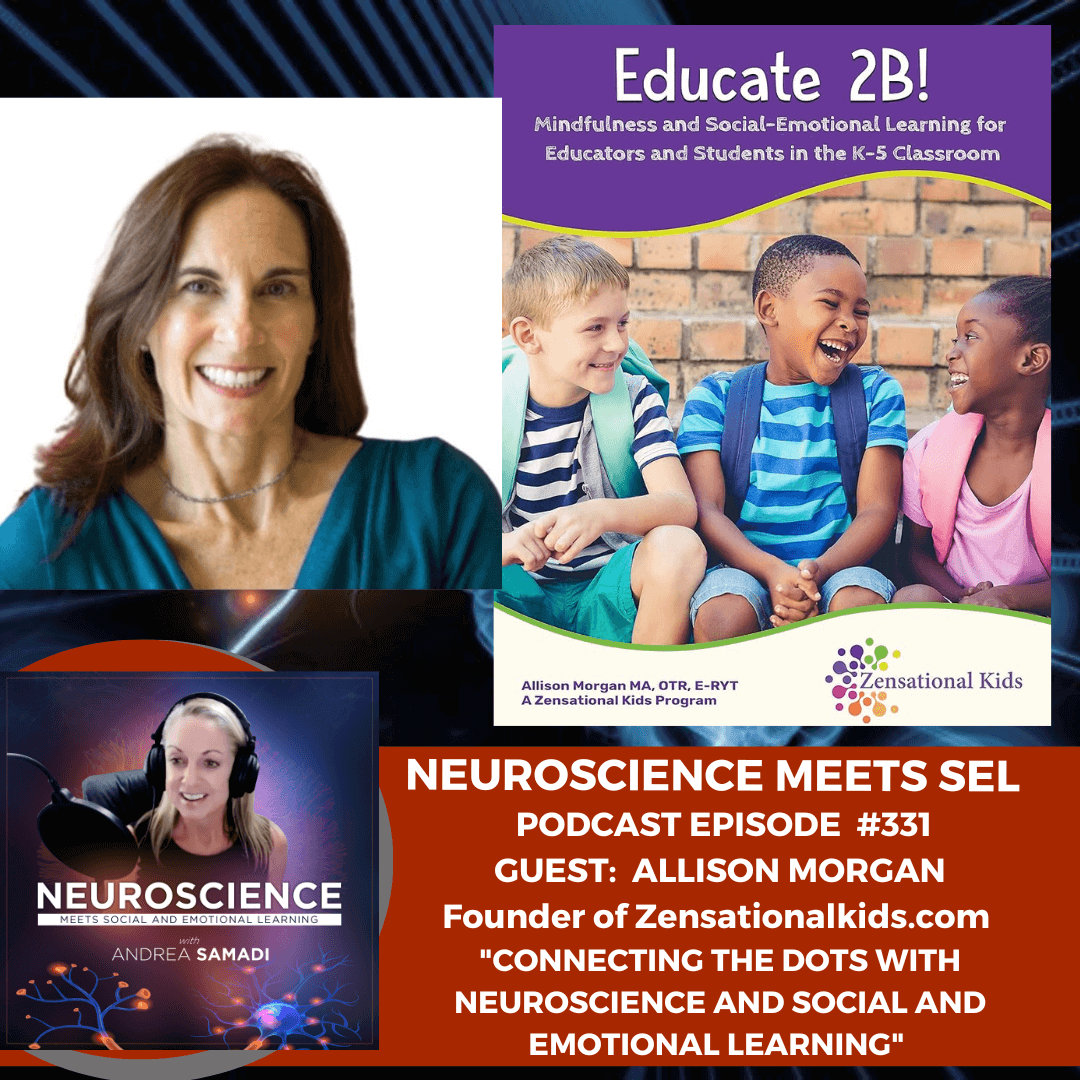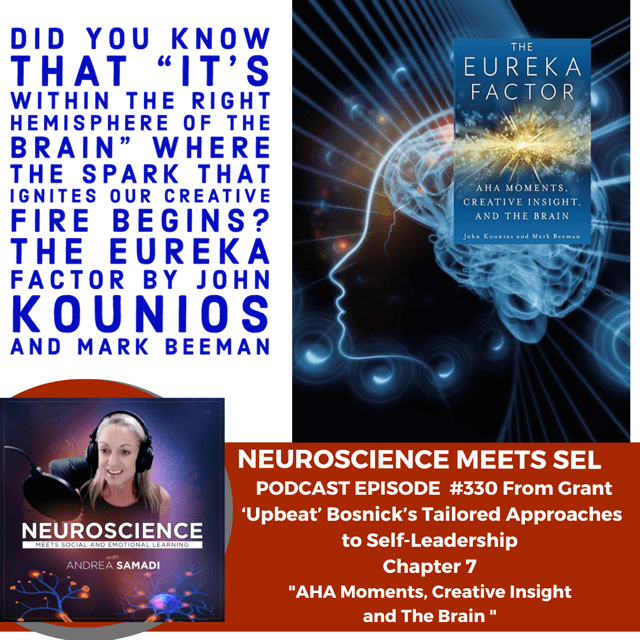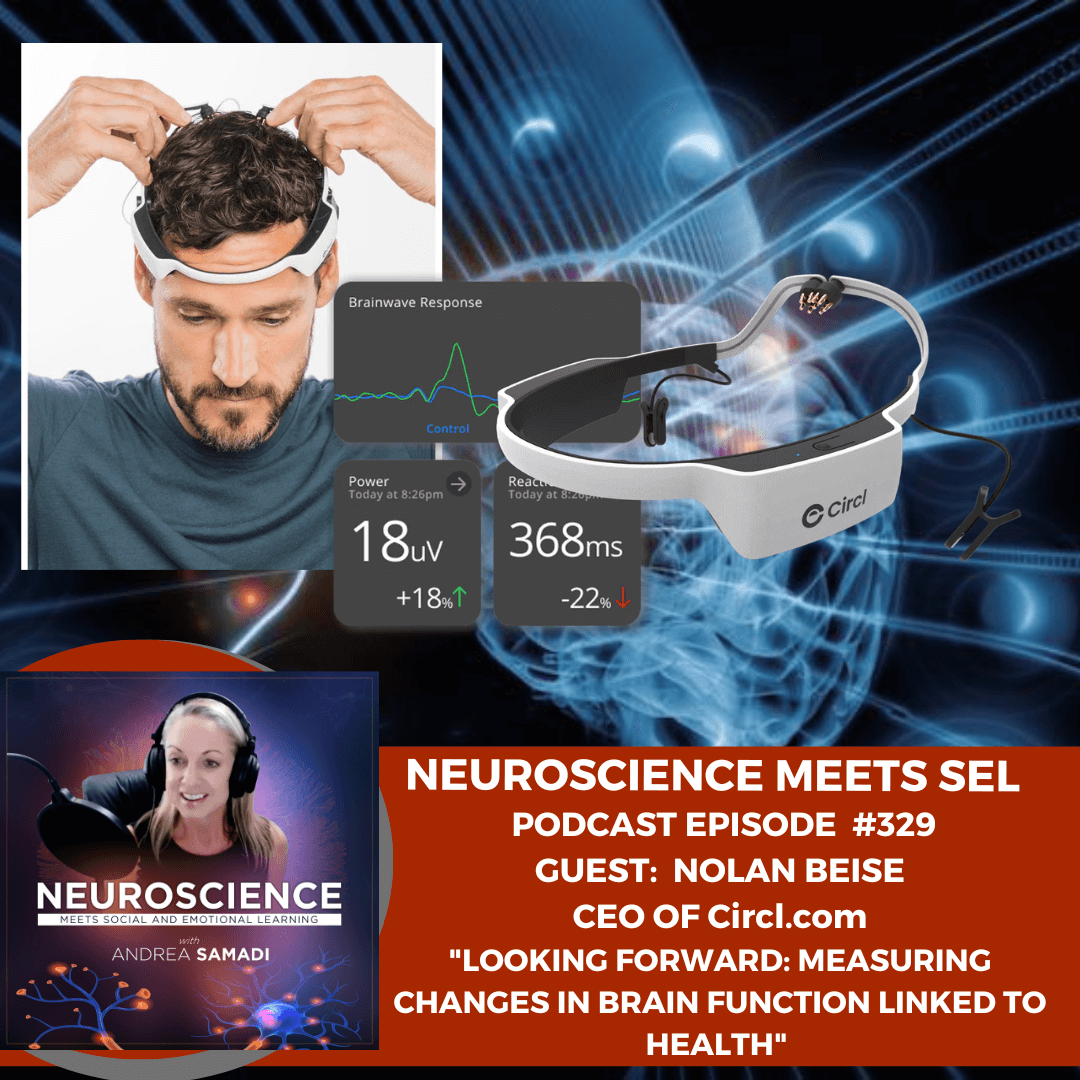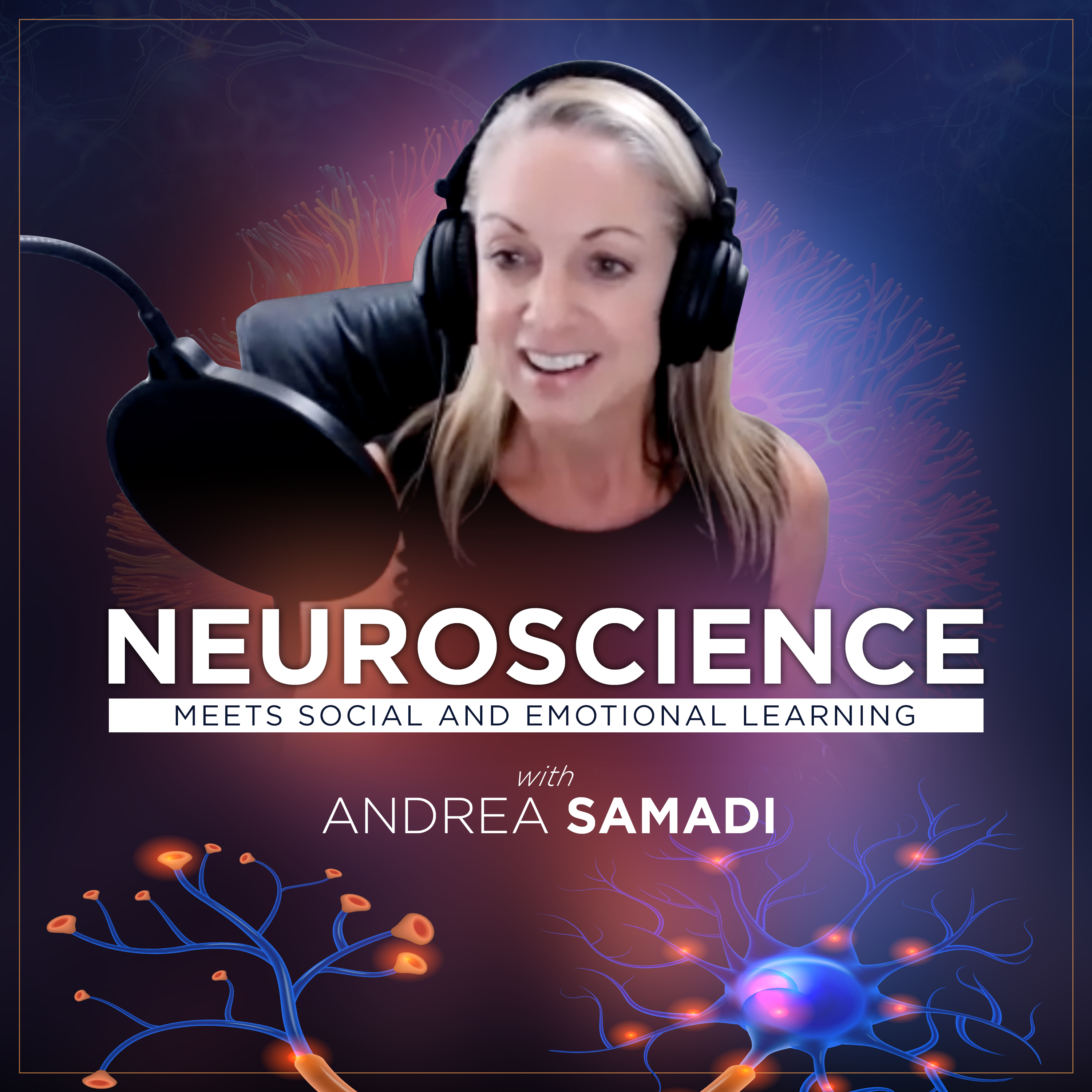“What makes aerobic exercise so powerful is that it’s our evolutionary method of generating that spark. It lights on fire on every level of your brain, from stoking up the neurons’ metabolic furnaces to forgiving the very structures that transmit information from one synapse to the next.” John Ratey, author of Spark: The Revolutionary New Science of Exercise and the Brain
On today’s Episode #277 we will cover
✔ A review of EP 177 on “Transforming the Mind Using Athletics and Neuroscience” to see what’s new.
✔ A look at Dr. Wendy Suzuki’s Brain-Changing Protocol to strengthen our hippocampus and prefrontal cortex.
✔ How to Create Your Own “Spark” to Take Your Results to New Heights.
And in today’s episode, I want us to all dive a bit deeper, beyond what I’ll uncover with the research, and look at this spark in our own lives. I want us to learn how to access this spark that John Ratey talks about, how to generate energy with this spark through exercise, and then figure out what we will do with this spark, or energy, once we’ve learned to create it, to go take ourselves to higher levels of achievement, all by using exercise and science, to take us there.
I want to welcome you back to The Neuroscience Meets Social and Emotional Learning Podcast, where we cover the science-based evidence behind social and emotional learning (for schools) and emotional intelligence training (in the workplace) with tools, ideas and strategies that we can all use immediately, with our brain in mind. I’m Andrea Samadi, an author, and educator with a passion for learning specifically on the topics of health, wellbeing and productivity, and launched this podcast almost 4 years ago, to share how important an understanding of our brain is, for our everyday life and results.
For today’s episode #277, we are going back to another favorite episode of mine, #122 on “Transforming the Mind Using Athletics and Neuroscience”[i] that we released April 9, 2021, after we interviewed Paul Zientarksi, the former PE teacher from Naperville Central High School, who reinvented physical education using the understanding of simple neuroscience. In this previous episode, we combined what we learned from Paul Zientarski,[ii] with our interview with Dr. John Ratey[iii], and his book Spark, that cemented the idea of the profound impact that exercise has on our cognitive and mental health.
For today’s episode, #277, we will go back to episode #122 on “Transforming the Mind Using Athletics and Neuroscience” and see what’s new with the research that might be able to take our understanding a bit deeper. I know that we all are clear on the fact that exercise creates that glorious protein called BDNF that we just reviewed thoroughly on EPISODE #274[iv] and even how this protein that is released when we exercise, is reduced in the brain of someone who has developed Alzheimer’s Disease, showing us that exercise is an imminent solution for the prevention of cognitive decline, or at least delaying this from happening for as long as we can.
Which leads me look deeper into the research on this topic, and I went straight to the work of neuroscientist and author, Dr. Wendy Suzuki, whose TED TALK on “The Brain-Changing Effects of Exercise”[v] has over 15 million views. I remember when her TED TALK came out (in 2017) and someone in my network sent it over to me and I immediately asked Dr. Suzuki to come on the podcast. After hearing what her schedule is like over the years, and the research she is involved with as the incoming Dean of Arts and Sciences at NYU[vi], I do understand now why I never did hear back from her on this request. Her TED TALK impacted me in a way where I knew I would need to focus on what she has discovered about the powerful effects of physical activity on the brain and that “by simply moving your body, this has lasting protective, benefits to the brain.” (Dr. Suzuki). Dr. Suzuki’s TED TALK, that came out years before we had looked at this topic on the benefits of exercise on the brain, that we started to unwrap with our interview with Dr. Ratey, explains how she was at the height of her work as a leading researcher on memory and the brain, when she stuck her head out of her lab she realized she was lacking in social interaction and had gained 25 LBS. She mentioned she was miserable, and launched her own exercise program, which is when she noticed things changing with her own brain. Not only did her mood improve, and she felt stronger, but she started to notice that her difficult work (grant writing which I know takes more brain power and patience than most of us have available on a day to day basis) but she noticed this daunting task was surprisingly getting easier for her, and she stopped and thought “What’s going on here? Could it possibly be my new exercise routine?”
I related to what she was saying (on many levels as I spent quite a few years working on grant writing) while also understanding there is no way I could ever sit at my desk and navigate through the research I need to do, without a daily exercise routine.
What about you? If you are listening to this episode, and caught the fitness bug at some point in your life, I wonder WHAT it was that inspired you to make physical activity a part of your daily routine?
When I thought about it, I would have to go back years to when I first noticed that exercise was something that just made me work better. I remember something clicked for me after high school, when I was at University, and spent my summers lifeguarding, to pay for that next year of school. In order to get the best pools as a lifeguard, in the City of North York where I grew up in Toronto, Canada, that were worth spending the entire summer at, there was this annual lifeguard triathlon, and those who participated, usually were given their first choice of the pool they wanted to work at. It was one of those “you’d better participate” and then you knew you would have a better chance at being happy with your work environment that summer.
And for many of us, living in Toronto, we lived for those summer months, poolside, with those we connected the most within our social circles, and many of us (or maybe it was just me) spent the entire winter dreaming of this special time of year, when the snow and ice melted, and the summer breeze filled the air. So, one year, I had set my mind of winning this summer triathlon, and started training for it in the winter. I joined the local YMCA and remember taking the bus from my house in Don-Mills to the YMCA on Sheppard and Bayview (at least a 30-min bus ride) where I would train, with the vision that I’d have a fancy pool to work at, with all of my favorite friends, while earning the money I needed to pay for University. As soon as the snow melted, I remember riding my bike, or rollerblading to the Y, but it was those days training for this one event that summer, that hooked me on being a regular daily exerciser, for the rest of my life.
An update on the triathlon that summer: I almost came in first, if I hadn’t have slipped and fell on the pool deck before the run, that was the final event. I was leading the whole race until my competitor, whose name I’ll never forget, passed me in that last stretch towards the finish line when I had nothing left to give. Good for her, I think today, as she motivated me in future years to keep training, and while we both got the pools we wanted, I know her love of athletics stayed with her for her lifetime as well.
Until revisiting this episode, I never really thought back to when I got the exercise bug, since it’s now became a non-negotiable part of my daily routine. When I heard Dr. Suzuki’s story, and learned about other people’s motivation for starting an exercise program, I thought it might help those listening to reflect back on their own story. It is interesting to think back to what is was that “sparked” this habit change, and made it stick, and if this isn’t a habit that you find interesting, at all, I’m hoping something in this episode creates that “spark” for you to perhaps begin your own program, with the health of your brain in mind.
Here’s where the research gets exciting! Dr. Suzuki mentions that “exercise is the most transformative thing that you can do for your brain” and listed some reasons that I think we have all heard of today.
She notes that with one 45-minute exercise session:
- YOUR MOOD IMPROVES: Exercise has immediate effects on your brain. One single workout she says, “increases neurotransmitters like dopamine, serotonin, and noradrenaline that will increase your mood immediately.” I think we can all agree on this one, and it’s one of the main reasons I’ve kept up my daily routine. I’m not much fun without these neurotransmitters flowing in my brain.
- YOUR FOCUS, ATTENTION AND EVEN YOUR REACTION TIME IMPROVE: and that this improved focus “can last up to 2 hours after you exercise.” Now I’m starting to think because I know in order to do difficult cognitive work, like reading through Pubmed.gov or something, I have to tire myself out early, and the harder the workout, the better I can think and focus on difficult work. I remember telling Dr. Ratey this in our interview and he said that’s why they had the students exercising before school, to prime their brain for learning.
BUT DID YOU KNOW THIS? THIS IS IMPORTANT…
Before switching her work to the impacts of exercise and the brain, Dr. Suzuki was one of the world’s leading researchers on memory. So of course, as she began to look at the impact of exercise on the brain, she would be looking at everything through the lens of a researcher whose spent years looking at the hippocampus (the brain’s memory center).
It’s her next points about how exercise improves our brain, through her memory research lens, that caught my attention.
She adds:
3. EXERCISE PRODUCES NEW BRAIN CELLS IN THE HIPPOCAMPUS: and this increases the volume of your hippocampus, improving your long-term memory. We have covered how to improve our memory, with unique memory hacks on a few episodes on this podcast, one with EPISODE #149 with our interview with Dave Farrow, Two-Time Guinness World Record Holder on “Focus, Fatigue and Memory Hacks”[vii] or even EPISODE #217 on “Science-Based Tricks to improve Productivity and Never Forget Anything.”[viii] But never once did we talk about the hippocampus (our brain’s memory center) in these episodes. Now Dr. Suzuki, a leading researcher on memory, exercise and the brain, tells us that exercise can make the part of our brain responsible for our memory, bigger? And with our brain, we all know that size matters.
4. THE MORE YOU EXERCISE, THE BIGGER AND STRONGER THE PREFRONTAL CORTEX GETS: So now we know that in addition to our memory center, (our hippocampus) that increases with exercise, we can add that the part of our brain that’s responsible for decision making, cognitive control, attention and focus, also gets bigger with exercise, and Dr. Suzuki elaborates that “these are the two areas of the brain most susceptible to neurodegenerative diseases and cognitive decline in aging.
While Dr. Suzuki says that “by increasing exercise over your lifetime, you’re not going to cure Alzheimer’s or Dementia, but what you will do is create the strongest and largest prefrontal cortex so that it takes longer for the disease to have an effect.” (Dr. Suzuki).
The whole reason why I spend all my spare time writing these podcast episodes, recording them, and putting them out to the world, for you, the listener, (and for me as well to keep learning) is that I do believe that small changes that we can all make, have the ability to completely transform our health, wellbeing and life.
Take for example, the recent episode we did on “The Damaging Impacts of Sugar on the Brain and Body”[ix] where we covered 2 people who were measuring their blood sugar. The only reason I had the data for this episode, was that someone close to me asked me for advice. One day, this person said to me, “if I was to do just a couple of things to improve my health, what would you suggest I do?” Now this person rarely ever comes to me for advice, so when it happened, I took the moment seriously. I looked them directly in the eye, and like Dr. Jacoby said to me when I asked him the same question, I answered back, without wavering, “You need to cut out sugar (and that means anything that turns into sugar after you eat it, like the obvious candy, bread, and alcohol and then measure your blood to see exactly how what you are eating affects you personally) and then you never eat those things again.” That was it.
In 30 days, this person lowered their A1C levels from the danger zone of 8.5 to 7.0. Once the behavior changes, so do the results. We can potentially reverse diabetes and pre-diabetes with this advice (and I say that not from the advice of my doctor, Dr. Jacoby, who swore that chronic disease is directly linked to lifestyle). Like Dr. Jacoby, I’m pretty militant about health, so my advice if you want to make changes with YOUR health, is to think of your own personal motivation for this change, and then find someone who won’t let you get away with reverting back to your old habits and behaviors, so that you’ll stick to the changes that support your brain health
So, back to Dr. Suzuki’s research. She mentioned that she often gets asked, “what’s the minimum amount of exercise that I would need to do, to get these changes in the brain?” and here’s what she suggests:
DR. SUZUKI’S BRAIN PROTOCOL:
Dr. Suzuki’s research revealed that the minimum amount of exercise you would need to do, to get these brain health benefits, would be 3-4 days a week, 30-45 minute sessions of aerobic activity, at an intensity that’s enough to get your heart rate up. She says you don’t have to go crazy, and I agree with her on this one.
Here’s something interesting I learned this year. Since I measure everything, I learned that certain activities get my heart rate just as high as my runs up the mountain. Activities like walking outside, lighter workouts on the elliptical, or even vacuuming the house, all get my heart rate up into ZONE 3 (70-80% of my maximum heart rate, or what would be considered a moderate exercise level). This was shocking to me, as I realized I could change up some of my activities, and save time, as long as I was able to get my heart rate up long enough for those brain benefits to take hold (for 30-45 minutes).
THINKING CREATIVELY WITH EXERCISE:
Now you can start to think creatively about aerobic activity. I recently noticed something while recording these podcast episodes. My WHOOP device started to log my activity recording as “other” and each time I finish recording, I would be notified, and could see that out of a 25 minutes recording session, I spent 70-80% of my maximum heart rate at the moderate exercise level. I’m not saying that sitting and recording for 25 minutes can replace a workout, but it opened my eyes to how strenuous public speaking can be on the body. I remember hearing speaker and author Brendon Burchard talking about how speaking in public “results in the same strain on his body as running a marathon each day.”[x] My WHOOP device was telling me the same story, and I’ve even noticed that when recording, I’m engaging muscles in my stomach to breathe, and it honestly feels like a workout session.
If you look at a graph of a typical hiking session, where I’m running up and down a mountain, my heart rate pattern is similar to when I’m recording a podcast episode, and recording or speaking into a mic logged me at 70-80% of my HR, which is ZONE 3 or a moderate exercise level. I do spend most of my hikes in ZONE 4 at 80-90% of my maximum heart rate, or the “hard” target zone, so I’m not going to replace this activity for speaking, but it really did open my eyes to thinking creatively with how else I can get my heart rate up for 45 minute sessions, with my brain in mind.
WHAT ELSE DOES DR. SUZUKI’S RESEARCH REVEAL?
While looking at the benefits of exercise on our brain, I wanted to go a bit deeper into what the research reveals, and there were a few more important details that I learned from Dr. Suzuki. She was interviewed on Dr. Andrew Huberman’s podcast on “Boosting Attention and Memory with Science-Based Tools”[xi] where she gave Dr. Huberman an overview of the most important points from her TED TALK, that now informed the research she was doing on exercise and the brain, through the lens of a leading researcher on memory.
BDNF, OUR HIPPOCAMPUS AND WHERE MEMORIES ARE STORED
Dr. Suzuki reaffirms some of what we’ve already covered, that “BDNF goes directly to our hippocampus and helps new brain cells to grow” which is what we knew from Dr. Ratey, who said that “BDNF is like Miracle-Go for the brain” and it’s from moving our muscles that this protein is created, helping us to improve “our highest thought processes.”
But Dr. Huberman wanted to dive a bit deeper into where our memories are actually stored in our brain and asked “isn’t the hippocampus involved in encoding memories, but not with the storage of memories? Memory storage (he asks) was in the neocortex or other overlying areas of the brain?” and Dr. Suzuki replies that he asked a tricky question because “memories are stored in the hippocampus for a very long time.”[xii] While she elaborates that people want to know “well how long are they there for before moving to the cortex” and she jokes “4 years, people want to know? Is that how long our memories are stored in our hippocampus?” I don’t need to be a neuroscientist to think that it doesn’t matter how long our memories are stored in our hippocampus, but I want this part of my brain to be as healthy, as big and fluffy (as she describes it) so that I can remain as sharp as I can as I’m aging. Not a day goes by that I go to grab a name of someone, and it’s not there, so this part of our brain is a muscle that needs to be worked, just as we would be moving our body with exercise.
LONDON CAB DRIVERS
Which led my mind back to the research that emerged with the hippocampus of London cab drivers. This part of their brain was “significantly larger in London cab drivers due to the mental workout they get while navigating the 25,000 streets of London.”[xiii]
REVIEW AND CONCLUSION:
To review and conclude this episode where we looked back at EPISODE #122 on “Transforming the Brain Using Athletics and Neuroscience” I think we’ve got a few NEW details to help build this case for the importance of adding at least, or at a minimum, 4 days a week of 45 minute moderate aerobic sessions to build a stronger, more resilient hippocampus, to help improve our thinking, decision-making, and our memory center, ensuring that neurodegenerative diseases that could possibly come our way with age, will at least be delayed, as remember with our brain, size does matter.
In the beginning of this episode, we spoke about a spark that exercise can create, that can help us to generate energy that we can use in our daily life. I mentioned where my spark began, training for the annual lifeguard triathlon in Toronto, to pay for my University classes, and I wonder:
IF YOU HAVE A REGULAR EXERCISE PROGRAM:
- If you have incorporated exercise into your daily routine, what it was that inspired you to begin?
- What was it that kept this habit going for you?
- Have you noticed specific examples of how your exercise program has transformed your brain (like Dr. Suzuki noticed with her grant writing getting easier, and I noticed with being able to sit for longer periods of time and be focused on higher cognitive work)?
- Have you ever thought about what exercise was doing for your brain, down to your memory center (how it makes it bigger and stronger) or your prefrontal cortex?
- Were you aware of how you were building the size of your brain with exercise to at least prevent the onset of cognitive decline as we age?
IF YOU DON’T HAVE AN EXERCISE PROGRAM:
- If you aren’t incorporating 3-4 days of aerobic activity lasting 30-45 minutes in your daily routine, does this research that shows how building a stronger, fluffier more resilient hippocampus and prefrontal cortex make you think about starting a routine? If the answer to this is yes, and you aren’t sure where to begin, check out our EPISODE on the TOP 5 Health Staples[xiv] where we covered how to get started with an exercise program as an Alzheimer’s Disease Prevention Strategy.
- Were you as surprised as I was about my WHOOP device picking up my heart rate while recording a podcast episode, showing us that we can get creative with how we increase our heart rate (like with vacuuming, or walking, or other activities where you don’t need to go crazy)?
- Can you think of some NEW and CREATIVE ways to start to move your body that could help your brain and cognition, now that you have seen this research?
Once you do begin this regular daily routine, I promise you that you will start to feel better. Like cutting out sugar, you will notice immediate changes in your body (mentally and physically), and you will start to notice that you have more creative energy that you can direct in many different places.
I promise you that this decision will “spark” something in you, that could possibly be the turning point that you needed to change your life forever.
Since I feel so strongly about health and wellness for all of us, I want to extend an offer to you. If you are listening to this episode, and you want to make an improvement with your health and wellness, and you are stuck, unsure of where to begin, send me an email to andrea@achieveit360.com and let me know where you are starting from. This is just me here offering to give you a bit of time if you feel stuck in some way, without having to worry if I’ll be selling you into some sort of coaching program. Sometimes in order to get started, we just have to make the decision, and talking to someone even for a few minutes, could be all you would need to “spark” some action of your end. If this is where you are sitting right now, don’t hesitate to reach out to me.
I’ll close out this episode with a quote from Dr. John Ratey who said that “exercise is the single best thing you can do for your brain in terms of mood, memory and learning.” I’m going to add that it’s the best thing we can do for ourselves as we age, to supercharge our hippocampus (our memory center) and prefrontal cortex (what we need to think) and build a stronger, more resilient brain so it will take longer for these degenerative diseases that we all know about, to have an effect.
And with that, I’ll make a promise back to you that I’ll keep thinking up new ideas to share with you here, because I know now that writing AND recording is good for my brain.
I’ll see you next week as we look at EPISODE #124 on “How to be a Neuroscience Researcher” and looking back at this episode, I’ll have to think really hard on how to make this one a bit more creative. See you next week.
FOLLOW ANDREA SAMADI:
YouTube Channel: https://www.youtube.com/c/AndreaSamadi
Website https://www.achieveit360.com/
LinkedIn: https://www.linkedin.com/in/samadi/
Facebook: https://www.facebook.com/Achieveit360com
Neuroscience Meets SEL Facebook Group https://www.facebook.com/groups/2975814899101697
Twitter: https://twitter.com/andreasamadi
Instagram: https://www.instagram.com/andreasamadi/
REFERENCES:
[i] Neuroscience Meets Social and Emotional Learning Podcast EPISODE #122 on Transforming the Mind Using Athletics and Neuroscience https://andreasamadi.podbean.com/e/brain-fact-friday-on-transforming-the-mind-using-athletics-and-neuroscience/
[ii] Neuroscience Meets Social and Emotional Learning Podcast EPISODE #121 with Paul Zientarski on “Transforming Students Using Physical Education and Neuroscience” https://andreasamadi.podbean.com/e/naperville-central-high-schools-paul-zeintarski-on-transforming-students-using-physical-education-and-neuroscience/
[iii] Neuroscience Meets Social and Emotional Learning Podcast EPISODE #116 with John J. Ratey, MD on “The Revolutionary New Science of Exercise and the Brain” https://andreasamadi.podbean.com/e/best-selling-author-john-j-ratey-md-on-the-revolutionary-new-science-of-exercise-and-the-brain/
[iv]Neuroscience Meets Social and Emotional Learning Podcast EPISODE #274 on “What’s NEW with BDNF: Building a Faster, Stronger, More Resilient Brain” https://andreasamadi.podbean.com/e/brain-fact-friday-what-s-new-with-bdnf-building-a-faster-stronger-more-resilient-brain/
[v] The Brain-Changing Effects of Exercise with Wendy Suzuki, 2017 https://www.ted.com/talks/wendy_suzuki_the_brain_changing_benefits_of_exercise?language=en
[vi] Wendy Suzuki https://as.nyu.edu/faculty/wendy-suzuki.html
[vii]Neuroscience Meets Social and Emotional Learning Podcast EPISODE #149 on “Focus, Fatigue and Memory Hacks for Students and the Worplace”https://andreasamadi.podbean.com/e/2-time-guinness-world-record-holder-dave-farrow-on-focus-fatigue-and-memory-hacks-for-students-and-the-workplace/
[viii]Neuroscience Meets Social and Emotional Learning Podcast EPISODE #217 on “Science-Based Tricks to improve Productivity and Never Forget Anything.”
[ix]Neuroscience Meets Social and Emotional Learning Podcast EPISODE #275 on “The Damaging Effects of Sugar on the Brain and Body” https://andreasamadi.podbean.com/e/brain-fact-friday-the-damaging-impacts-of-sugar-on-the-brain-and-body/
[x] Brendon Burchard’s High Performance Habits Story by Amy Anderson https://brendon.com/blog/success/
[xi]Dr. Wendy Suzuki on The Huberman Lab Podcast #73 “Boosting Attention and Memory with Science-Based Tools” https://www.youtube.com/watch?v=099hgtRoUZw
[xii] Dr. Wendy Suzuki on The Huberman Lab Podcast #73 “Boosting Attention and Memory with Science-Based Tools” https://www.youtube.com/watch?v=099hgtRoUZw 38:26 time stamp
[xiii] Taxi Cab Drivers’ Brains Grow to Navigate London’s Streets By Ferri Jabr December 8, 2011 https://www.scientificamerican.com/article/london-taxi-memory/
[xiv] Neuroscience Meets Social and Emotional Learning Podcast EPISODE #87 on “The Top 5 Brain Health and Alzheimer’s Prevention Strategies” https://andreasamadi.podbean.com/e/do-you-know-the-top-5-brain-health-and-alzheimers-prevention-strategies-with-andrea-samadi/
Podcast: Play in new window | Download
Subscribe: Apple Podcasts | RSS





